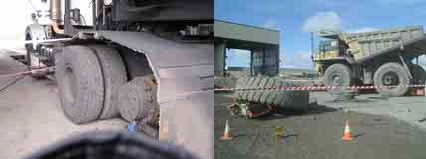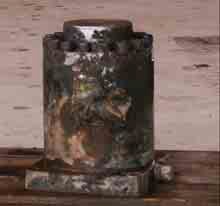
Mines safety bulletin no. 70 | 08 November 2007 | Version 1
Hazards of stored energy
In Queensland in the past five years, at least five fatal accidents in mining or mining related industries have been due to an uncontrolled release of stored energy.
Of the five fatal accidents, one involved disassembling a cylinder containing a piston under pressure, another involved disassembling a fitting in a compressed airline, and three involved inflated tyres.
Equipment from the first of these incidents is shown below. Bolts securing the end cap of the cylinder were being removed while the piston was still under pressure. The piston appeared to be in a relaxed state, almost fully contained in the cylinder, giving no visible indication of the contained pressure.
For cylinders containing stored pressure, the steps for controlling the risks are:
- discharge energy in accordance with manufacturers' procedures
- confirm the energy has been released (do not rely on visible indicators)
- remove a plug, valve or hose and keep separate from the cylinder (an open circuit cannot contain pressure)
- if the item containing stored energy is to be transported from the site then:
- reduce the energy in the item to as low as possible
- clearly mark the item, to alert the receiver to the energy state.
The second of the incidents occurred when the 63mm plastic nut was unscrewed to remove the valve assembly from the end of a pressurised pipeline.
The steps to control the risks of compressed air pipelines are:
- before working on a pipeline, isolate the pipe section and discharge the compressed air
- if available, use fittings that contain a pressure active warning device
- the discharge valve should be left open and clearly marked (if possible, locked open).
Two of the three incidents involving tyres were caused by removal of an inflated tyre and rim assembly from a truck. The components of the multi piece rims catastrophically separated, as the retaining nuts were removed, due to a dislodged lock ring and a cracked rim.
The steps to control tyre pressure hazards are:
- maintenance should not be carried out on tyres or wheel assemblies while the tyres are inflated
- when handling or transporting tyres, they should be deflated to zero pressure. Handling difficulties may require a low pressure to be maintained in some circumstances. The residual pressure should be clearly marked on the tyre as a warning of the contained energy
- when performing hot work on a rim or wheel, the tyre should be removed from the assembly before work commences.
There are numerous examples of plant containing stored energy, e.g. springs, air receivers, hydraulic hoses, conveyor counterweights, airlines, tyres, capacitors and batteries etc. Each has its own unique technique for removal or control of the inherent hazard of stored energy.
In general there are four basic steps to control these risks:
- isolation of the energy source
- maintaining the method of isolation
- releasing or containing the stored energy
- confirming the stored energy has been dissipated or contained.
In the case of the five fatal accidents, the correct procedure should have been to release the stored energy. This would eliminate the hazard by using the highest level of risk control.
The following documents provide an invaluable source of reference for hazard control:
- The Coal Mining Safety and Health Act 1999 and the Coal Mining Safety and Health Regulation 2001, including Section 80 Fluid above and below atmospheric pressure.
- The Mining and Quarrying Safety and Health Act 1999 and Mining and Quarrying Safety and Health Regulation 2001, including Sections 107 Isolating, locking-out and tagging plant, 111 Dismantling and demolition and 112 Specifications, instructions and other information about plant.
- Department of Mines and Energy Guidance Notes, QGN01 Out of Service Procedures, and QGN02 Isolation Procedures.
- Department of Mines and Energy Safety Bulletins numbers 41 Working on compressed air lines, 49 Isolation of plant containing stored energy, and 67 Managing high pressure fluids and gases.
- Department of Mines and Energy Safety Alert 136 Fatal injury to prime mover operator as rim assembly fails.
- Australian Standard AS 4343 Pressure equipment - Hazard levels.
- Relevant parts of the AS 4024, Safety of machinery, series of Australian Standards.
Contact: minesafetyandhealth@dnrm.qld.gov.au
Issued by Queensland Department of Mines and Energy
Find more safety notices
Search the hazards database



